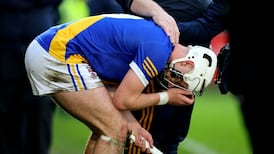A kindly woman organises a surprise birthday party for a cantankerous old uncle. Having arranged everyone in their places, poised quietly pending the arrival, she welcomes him, guides him to a room and flicks on the lights.
There may be a few half-hearted cries of “Surprise!” but the effect is not as hoped for; instead a scowl and a bark: “What are you all doing here?”
GAA director general Páraic Duffy is not by nature cantankerous but he did pose the same question last month in his annual report, which he will present to congress.
With the Gaelic games season now in full flight and – miraculously – having lost virtually no fixtures to the apocalyptic weather, anyone could be forgiven for overlooking a significant alteration to the GAA calendar.
It won’t necessarily set pulses racing but this year’s annual congress will take place at the weekend. A switch in the association’s financial year end to October has prompted the decision to bring forward congress also by two months.
What are you all doing here?
The composition of congress is governed by rule 3.36, which specifies that representation is one delegate per 10 clubs, with various qualifications to cater for small and very large units. Three hundred and twenty delegates are due in Croke Park this weekend.
In his report, Duffy made the following point about annual congress:
Size of delegations
"One issue that has still not been addressed is the size of delegations.
“Previous efforts to reduce the size of congress and to change the voting representation petered out, but, whatever the ratio of clubs to votes, it is a matter of concern that the number of clubs registered does not seem to be an accurate reflection of the actual situation.
"Provincial Councils submit the number of registered clubs in the province to my office, and representation at Congress is based on these figures. However, these figures do not seem to reflect either the representation on the Club Wall or Injury Scheme contributions.
“When Congress 2014 has ended, it will be time to look again at representation to ensure that it is equitable and totally democratic, and that it facilitates effective decision-making.”
How do these discrepancies arise? In counties where one of the games isn’t as strong as the other it’s not uncommon for an amalgamated team in the weaker code to be established in an area or for age-grade sides to be assembled from a number of clubs with low-population catchments.
To meet the requirements of Chapter 6 (Games and Competitions), these assembled teams count as clubs but obviously don’t have a fully independent existence nor a separate membership.
As a result there are discrepancies in the delegate counts. According to the booklet (containing the annual report and finances), which will be in circulation at the weekend’s congress there are 2,518 affiliated clubs but the county-by-county breakdown doesn’t tally with what might be described as active clubs.
Spot checks on a number of counties show the official figures for affiliated clubs differs, as Duffy points out, from the numbers shown on the Club Wall, the display on either side of the Croke Park Museum entrance, unveiled by then president Christy Cooney nearly four years ago, which purports to feature the crest of every club in Ireland and abroad.
Official figure
For example Cork's official figure is 259 whereas the numbers on the wall are about 100 fewer. The figures for Duffy's own county, Monaghan, are respectively 50 and 34.
Furthermore, the list of clubs on the counties’ websites corresponds to the lower figure.
There’s nothing suspicious about the numbers, as the setting up of the additional “clubs” is required by rule and in Cork’s case, their delegation wouldn’t actually be affected as they have the largest number of clubs in the country and even at 155, would easily qualify for the maximum representation of 10.
Overall, though, it supports Duffy’s view that congress representation should be reviewed. It would make sense if that representation was based on actual membership rather than clubs, some of which are temporarily assembled from already existing members of the GAA.
There are, however, a number of things about congress in general that could be looked at. There are, for example. 63 motions on Saturday's clár and yet only two of them – the extension of match bans instead of time-based suspensions to club activity as well as county and the proposal to stop penalty-takers in hurling from stealing yards on the 20-metre line – have in any way engaged wider attention.
Tweaking rules
The vast preponderance of motions concern what can be described as house-keeping matters, tweaking rules to iron out anomalies or take into account Central Council and DRA decisions since the last congress. There are few big-idea proposals.
Whereas the Rules Advisory Committee has done, and continues to do, valuable and necessary work in keeping the rule book up to date, many of its proposals are highly technical, unlikely to trigger much in the way of debate and arguably would be better dealt with by Central Council.
Does the whole business really require the attendance of 320 delegates over two days?
smoran@irishtimes.com













